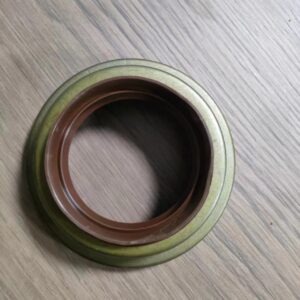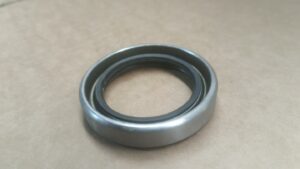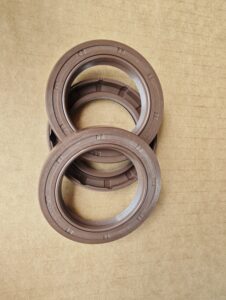Table of Contents
ToggleWhat Are Automotive Seals?
Automotive seals are precision-engineered components critical to vehicle functionality, designed to retain fluids, exclude contaminants, and maintain system integrity. Found in engines, transmissions, brakes, and more, they ensure reliable performance, longevity, and safety. Below is a comprehensive guide to their roles, types, materials, and applications.




Core Functions of Automotive Seals
- Fluid Retention
- Prevent leakage of oils, coolants, fuels, and hydraulic fluids.
- Example: Crankshaft seals keep engine oil within the crankcase.
- Contaminant Exclusion
- Block dirt, water, and debris from entering sensitive components.
- Example: Wheel hub seals protect bearings from road grit.
- Pressure Regulation
- Maintain hydraulic or pneumatic pressure in systems like transmissions and turbochargers.
- Example: Transmission seals ensure stable fluid pressure for gear shifts.
- Friction Reduction
- Minimize wear by ensuring lubrication between moving parts.
- Example: Camshaft seals direct oil to valve train components.
Types of Automotive Seals
| Type | Design & Features | Primary Applications |
| Lip Seals | Spring-loaded rubber lips with metal case | Crankshafts, axles, wheel hubs |
| O-Rings | Elastic loops (NBR, FKM, silicone) | Fuel injectors, coolant lines, A/C systems |
| Gaskets | Flat sheets (rubber, cork, composite) | Cylinder heads, oil pans, valve covers |
| Mechanical Seals | Precision carbon/ceramic faces | Turbochargers, high-pressure pumps |
| Cassette Seals | Housed units with integrated elastomers | Wheel hubs, heavy-duty transmissions |
| PTFE Seals | Low-friction, chemical-resistant | Fuel systems, high-temperature zones |
Material Selection & Compatibility
| Material | Key Properties | Applications |
| Nitrile (NBR) | Oil-resistant, cost-effective | Engine oil seals, fuel lines |
| Viton® (FKM) | High heat/chemical resistance (-20°C–200°C) | Turbochargers, transmission seals |
| EPDM/HNBR | Glycol/water resistance, flexible | Cooling systems, water pumps |
| Silicone | Extreme temperature flexibility | Intake systems, coolant hoses |
| PTFE | Low friction, inert to chemicals | Fuel pumps, hydraulic systems |
Key Applications in Vehicles
- Engine System
- Crankshaft seals: Retain oil around rotating shafts.
- Valve stem seals: Regulate oil flow to prevent combustion chamber leaks.
- Timing cover seals: Shield timing belts/chains from debris.
- Transmission/Drivetrain
- Input/output shaft seals: Contain transmission fluid.
- Differential seals: Protect gear oil in axle assemblies.
- Wheels & Brakes
- Hub seals: Retain grease in wheel bearings.
- Brake caliper seals: Maintain hydraulic pressure for braking.
- Ancillary Systems
- Power steering seals: Prevent fluid leaks in hydraulic systems.
- A/C compressor seals: Retain refrigerant and lubricant.
Consequences of Seal Failure
- Fluid Leaks: Low oil/coolant levels → overheating or component damage.
- Contamination: Grit ingress → accelerated bearing/gear wear.
- Pressure Loss: Reduced efficiency in turbo or hydraulic systems.
- Costly Repairs: Ignored leaks may require engine rebuilds or transmission replacements.
Example: A failed rear main crankshaft seal can drain engine oil, leading to catastrophic seizure.
Maintenance Best Practices
- Regular Inspections
- Check for cracks, leaks, or wear during routine servicing.
- Timely Replacement
- Replace seals per manufacturer intervals or during overhauls.
- Proper Installation
- Ensure shafts are smooth and seals are aligned to avoid damage.
- Material Compatibility
- Use EPDM for coolant systems, Viton® for high-heat zones.
Innovations in Seal Technology
- Hybrid Materials
- EPDM-Viton® blends for multi-fluid resistance.
- Low-Friction Coatings
- PTFE coatings reduce wear in high-speed applications.
- Smart Seals
- Embedded sensors monitor wear and fluid integrity (emerging tech).
How Seals Work: Dynamic vs. Static
- Dynamic Sealing (Rotating/Reciprocating Shafts):
- A spring-loaded elastomer lip presses against a shaft (e.g., crankshaft seals).
- Metal casing creates a static seal with the housing.
- Static Sealing (Fixed Joints):
- Gaskets compress between surfaces (e.g., cylinder head gaskets).
Why Proper Selection Matters
- Material Mismatch: Using NBR in coolant systems causes swelling.
- Geometry & Pressure: Incorrect lip design leads to leaks under high pressure.
- Temperature Limits: Silicone seals crack if exposed to engine oil heat.
Summary
Automotive seals are indispensable for fluid retention, contamination control, and system efficiency. They range from simple O-rings to complex mechanical seals, each tailored for specific roles. Material choice (NBR, Viton®, EPDM) ensures compatibility with operational stresses like heat, friction, and chemicals. Regular maintenance and correct installation are vital to prevent failures that compromise vehicle performance.



Leave A Comment